#token development platform
Explore tagged Tumblr posts
Text
Token development services by Blockchainx
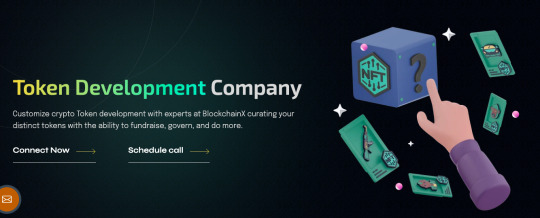
Accelerate crypto token development with BlockchainX. Our platform enables seamless introduction, customization, and deployment of tokens, empowering organizations to innovate and tokenize assets effortlessly.
Visit: Token development services
#token development services#crypto token development services#token development platform#token development company#blockchainx
0 notes
Text
A newly established social media platform where you can earn cryptocurrency. The platform is still under development, keeping pace with modern technologies such as cryptocurrency exchange.
https://www.soc-web6.com/share/person/109023952345758776?code=AIHWWPDX
Invitation code: AIHWWPDX
You'll find plenty of explanations on YouTube.

#social media platform#socrates#perseverance#code#soc#earn tokens#Solutions#like#Invitation code#development#Modern generation#Tweet#Space for expression#cryptocurrency
42 notes
·
View notes
Text
Secure DeFi Wallet Development: Ultimate Guide for Blockchain Solutions
This comprehensive guide to DeFi wallet development explores how blockchain technology can transform decentralized finance. It highlights key features like enhanced security, tokenized rewards, smart contract governance, and censorship resistance.
Designed for developers and blockchain enthusiasts, the blog offers insights into building user-friendly wallets that ensure privacy and seamless transactions. By addressing issues like data breaches and centralized control, this guide provides a roadmap for creating innovative and secure blockchain solutions.
A must-read for anyone in the decentralized finance space!
#defi wallet development#defi crypto lending platform development#Secure DeFi wallet development#blockchain development for defi#defi platform development#defi token development#defi lending platform development#defi lending and borrowing platform development#defi development#defi wallet app development#defi lending/ borrowing platform development#defi wallet development service#decentralized lending and borrowing platform development#defi blockchain development#lending borrowing platform development#defi development platform#defi development company#defi lending platform development services#defi platform development company#defi smart contract development#defi smart contract development company#defi smart contract development services#defi development services#defi development provider#crypto defi wallet development services
2 notes
·
View notes
Text
Explore the complete 2025 guide to Art Tokenization Platform Development. Learn how to digitize, fractionalize, and trade art securely using blockchain technology. check out us : https://www.blockchainx.tech/art-tokenization-services/
#Art Tokenization Platform#Art Tokenization Platform Development#rwa tokenization#tokenization#technology#blockchain
0 notes
Text
Top Real Estate Tokenization Platforms to Watch in 2025
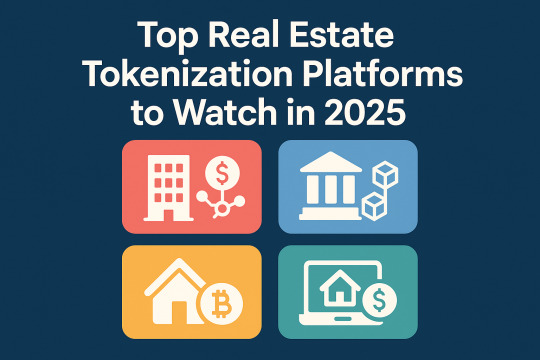
The real estate industry isn’t what it used to be—and that’s a good thing. With blockchain technology making waves in almost every sector, property investment is no exception. One of the most exciting innovations is real estate tokenization, where ownership of real-world assets is represented by digital tokens on a blockchain. Sounds futuristic? It’s already here—and in 2025, it's only going to get bigger.
Let’s dive into the world of Real Estate Tokenization Platforms, explore how they work, and discover the top contenders shaping this revolutionary trend.
Introduction to Real Estate Tokenization
What Is Real Estate Tokenization?
In simple terms, tokenization is the process of converting ownership rights in a property into digital tokens stored on a blockchain. Instead of needing millions to buy a building, you can own a small percentage—say $100 worth—via a token. It’s like crowdfunding meets crypto, but smarter.
Why Is Tokenization Revolutionizing Property Investment?
Because it democratizes real estate. Tokenization allows almost anyone to invest in high-value properties without going broke. It also brings efficiency, security, and transparency to an industry long burdened by red tape.
Benefits of Real Estate Tokenization Platforms
Fractional Ownership
Want to own part of a luxury villa in Bali or a condo in Manhattan? With tokenization, you can. Fractional ownership reduces the barrier to entry and allows diverse portfolios for investors of all levels.
Enhanced Liquidity
Traditionally, real estate is a highly illiquid asset—you can’t just sell a piece of your house on a whim. Tokenization makes it possible to trade real estate tokens much like stocks or crypto, offering liquidity that was previously unimaginable.
Global Investment Opportunities
Geography is no longer a limitation. You can sit in Singapore and invest in a property in Paris, instantly. These platforms make real estate a truly global game.
Transparent Transactions with Blockchain
Blockchain ensures all transactions are recorded immutably and transparently. No middlemen. No hidden terms. Just clear, verifiable data.
What to Look for in Real Estate Tokenization Platforms
Regulatory Compliance
Tokenizing real estate isn’t a free-for-all. Platforms must comply with SEC, AML, and KYC regulations. Always opt for platforms that put compliance front and center.
Platform Usability and Interface
An intuitive dashboard, easy navigation, and seamless user experience are non-negotiable. If it feels like you're trying to decode The Matrix, look elsewhere.
Blockchain and Smart Contract Integration
Platforms built on reliable blockchains like Ethereum or Polygon with robust smart contract functionality ensure smoother transactions and greater trust.
Custodial and Wallet Features
Whether it's integrated wallets or third-party custodians, the safekeeping of your tokens is crucial. Bonus if the platform supports multi-sig wallets or cold storage.
Top Real Estate Tokenization Platforms to Watch in 2025
The market is growing fast, but a few platforms are clearly leading the pack. Let’s spotlight the real game-changers.
1. Shamla Tech
Key Features
Custom real estate tokenization development
Blockchain integration (Ethereum, BNB Chain, Polygon)
Security token offering (STO) solutions
KYC/AML compliance modules
Pros & Cons
Pros: Highly customizable, enterprise-grade development, supports global standards Cons: Requires technical onboarding for custom setups
Shamla Tech stands out as a top real estate tokenization development company in 2025, offering tailored solutions for startups and enterprises alike. Whether you’re looking to launch a fully tokenized real estate investment platform or need STO consulting, Shamla Tech provides full-stack services to get you there securely and efficiently.
2. Lofty AI
Key Features
Properties vetted using AI analytics
Low minimum investment (starting at $50)
Secondary market for token trading
Pros & Cons
Pros: AI-powered property selection, excellent liquidity Cons: Still expanding property variety
3. HoneyBricks
Key Features
Focus on commercial real estate
Accredited investor-only platform
Tokens issued on Polygon
Pros & Cons
Pros: High-value assets, efficient blockchain Cons: Not accessible to non-accredited investors
4. SolidBlock
Key Features
One of the pioneers in tokenizing real estate
Focuses on high-end commercial properties globally
Offers both STO (Security Token Offering) and white-label solutions
Pros & Cons
Pros: Strong track record, customizable solutions Cons: Less focus on retail investors
5. Smartlands
Key Features
European-based platform
Tokenizes both real estate and agriculture
Regulated under UK financial laws
Pros & Cons
Pros: Diversified asset class, highly compliant Cons: Limited availability outside Europe
6. ReitBZ by BTG Pactual
Key Features
Created by Latin America’s biggest investment bank
Invests in distressed real estate
Tokens available via Ethereum
Pros & Cons
Pros: Backed by a financial giant, real institutional credibility Cons: Limited property transparency, less retail-focused
Future of Real Estate Tokenization
Trends to Watch in 2025
AI + Tokenization: Platforms will increasingly use AI to assess market trends and property values.
Interoperability: Token standards will allow tokens to move freely across platforms and blockchains.
DAO Governance Models: Token holders might soon vote on property management decisions.
Challenges in the Sector
Regulatory uncertainty
Low awareness among traditional investors
Cybersecurity threats
The Role of Regulations Moving Forward
2025 will be a defining year as governments worldwide finalize their stances on security tokens. Expect clearer frameworks, which should attract institutional money and build user confidence.
Final Thoughts
Real estate tokenization is no longer a concept—it's a movement. As we inch closer to 2025, these platforms are transforming how people invest in properties. Whether you’re a seasoned investor or a curious beginner, getting in early could mean reaping the rewards of tomorrow's real estate boom today.
Just remember: do your homework, understand the risks, and choose your platform wisely.
FAQs About Real Estate Tokenization Platforms
1. What is the minimum investment amount on tokenization platforms? It varies, but some platforms like Lofty AI allow investments as low as $50.
2. Are tokenized real estate platforms safe? If regulated and built on secure blockchains, they’re relatively safe. Always look for platforms that comply with financial laws.
3. Can I sell my tokens anytime? Many platforms offer secondary markets for trading, but liquidity depends on platform structure and demand.
4. Do I earn rental income with real estate tokens? Yes! Most platforms distribute rental income periodically, usually in stablecoins.
5. Are there tax implications? Absolutely. Income from tokens and capital gains may be taxable in your jurisdiction. Always consult a tax advisor.
#asset tokenization platform development#real estate tokenization platform development#real world asset tokenization#tokenization of real world assets#tokenizing real world assets#rwa tokenization companies#real estate token development company
0 notes
Text

NFTs as Security: How DeFi Platforms Are Changing the Lending Game
Introduction
Non-fungible tokens (NFTs) have exploded onto the scene, transforming how we think about digital ownership. At their core, NFTs are unique digital certificates stored on a blockchain, certifying authenticity and provenance for items like art, music, or virtual real estate. As decentralized finance (DeFi) grows, innovative platforms now let you use NFTs as collateral, turning art into loans and collectible cards into cash. Behind many of these breakthroughs stand dedicated teams: NFT token development companies offering NFT token development services, crafting seamless experiences that bridge creativity and finance. In this post, we’ll explore how NFTs are reshaping lending, the benefits and risks involved, and what lies ahead for this exciting intersection.
Understanding NFTs and DeFi Platforms
NFTs represent one-of-a-kind digital assets. Unlike cryptocurrencies such as Bitcoin or Ether, which are interchangeable, each NFT is distinct and carries its own value. DeFi platforms, on the other hand, are decentralized applications built on blockchains that replicate traditional financial services—lending, borrowing, trading—without banks or middlemen. When you tap into a DeFi platform, smart contracts automatically enforce the terms of your transaction, making processes transparent and often faster. Many of the leading NFT token development solutions now integrate these platforms, enabling smooth minting, listing, and trading of NFT transferable assets within DeFi ecosystems.
The Role of NFTs in DeFi Lending
So, how do NFTs fit into the world of borrowing and lending? Traditionally, borrowers use collateral like Ether or stablecoins to secure loans. With NFT collateralization, you pledge an NFT—say, a digital painting or a rare avatar—to back a loan. If you repay on time, you get your NFT back; if not, the platform can sell it to recover the funds. This model unlocks new liquidity for NFT holders. Behind the scenes, an NFT token development company often provides the underlying smart contracts and user interfaces that make this possible, ensuring your NFT transferable assets move securely and automatically between your wallet and the lending pool.
Models of NFT Lending in DeFi
DeFi platforms have experimented with various lending models for NFTs:
Fixed Loans: You lock your NFT for a set period and receive a predetermined loan amount.
Auction-Based Lending: Borrowers bid to pledge their NFTs, and lenders bid on loans, with interest rates set by supply and demand.
Fractional Loans: Multiple lenders pool funds to back a single high-value NFT, each receiving proportional collateral rights.
NFT token development services play a key role in building these models, offering customized smart contracts that suit each platform’s needs. Whether you’re a creator seeking lending flexibility or an investor hunting yield, these innovative solutions expand your DeFi toolkit.
Benefits and Risks of Using NFTs as Security in DeFi Lending
Benefits
Instant Liquidity: NFT holders can access capital without selling their prized pieces.
Enhanced Yield Opportunities: Lenders earn interest on idle funds by backing NFT loans.
Diversification: Adding NFT loans to a DeFi portfolio spreads risk across different asset types.
Risks
Valuation Challenges: Unlike fungible tokens, NFT prices can swing wildly based on trends or hype.
Smart Contract Vulnerabilities: Bugs in the code could put collateral at risk.
Market Liquidity: If an NFT is hard to sell, lenders may struggle to recover funds in a default.
That's why choosing robust NFT token development solutions is crucial—thorough auditing, clear documentation, and continual updates help minimize these risks and build trust in the system.
Legal Developments and Innovations Enhancing NFT Utility in DeFi Lending
As NFTs enter mainstream finance, regulators and innovators alike are adapting. Some jurisdictions now clarify how NFTs fit into securities law, helping platforms operate with confidence. Companies offering NFT token development services are increasingly integrating compliance features, like identity verification and transaction reporting, directly into smart contracts. Meanwhile, innovations like cross-chain bridges enable NFT collateral to move between blockchains, expanding options for both borrowers and lenders. Together, these advances are turning NFT collateralization from a fringe experiment into a more widely accepted financial tool.
Shaping Traditional Lending Practices with NFTs on DeFi Platforms
The rise of NFT-backed loans is influencing traditional finance too. Banks and credit unions are exploring partnerships with DeFi platforms or even developing in-house NFT token development divisions. They recognize that digital scarcity and immutable ownership records can enhance loan security. Some legacy institutions are piloting NFT-secured lending products, bringing straightforward processes and familiar customer support to a new generation of digital collectors. Over time, we may see hybrid models where legacy finance and DeFi interoperate, offering the best of both worlds.
The Future of Finance: Embracing NFTs as Security on DeFi Platforms
Looking ahead, NFTs will likely become a staple in DeFi lending. As the market matures, we’ll see more sophisticated valuation oracles that price NFTs in real time, advanced risk-scoring algorithms, and platforms offering bundled NFT collateral packs. NFT token development companies will keep innovating, delivering turnkey NFT token development solutions that make integration seamless for any project. In parallel, the concept of NFT transferable assets will expand beyond art and collectibles into areas like real estate tokens, intellectual property rights, and membership passes, each unlocking fresh lending possibilities.
Conclusion
NFTs as collateral mark a pivotal shift in decentralized finance, blurring the lines between digital art, gaming items, and traditional lending. By tapping into NFT token development services and leveraging reliable NFT token development companies, creators and investors can unlock the hidden value in their digital holdings without giving them up permanently. As legal frameworks evolve and technology improves, NFT collateralization platforms will only grow more secure and accessible. Whether you’re an artist seeking liquidity or a lender hunting yield, embracing NFTs as security on DeFi platforms offers a dynamic, human-centered pathway into the future of finance.
#nft token development#nft token development company#NFT token development services#NFT token development solutions#Defi development company#Defi platform development#NFT Collateralization platform development
0 notes
Text
How Asset Tokenization Platforms Maximize Investor ROI
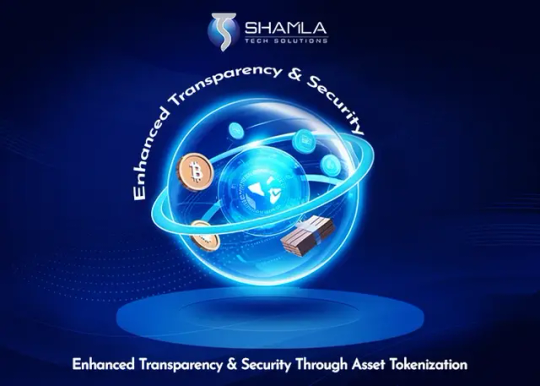
Dive deep into the world of Asset Tokenization Platform Development and learn how Real World Asset Tokenization Benefits can significantly improve portfolio performance and diversification. Unpack the technological layers of Real World Asset Tokenization Development and see how modern platforms ensure security, compliance, and efficiency in tokenizing physical assets.
#Asset Tokenization Platform Development#Asset Tokenization Benefits#Asset Tokenization Platform benefit investors
0 notes
Text
Build the Future of Gaming with Crypto Casino Development Solutions
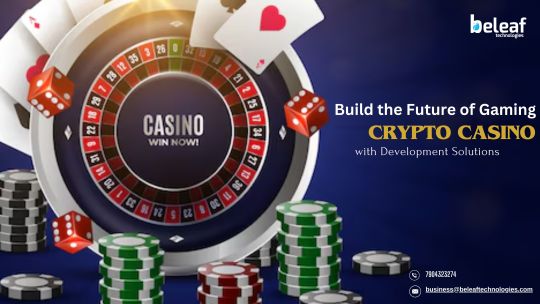
#In a world where innovation drives the gaming industry#the rise of crypto casino game development is reshaping the way players and developers think about online gambling. This is because blockch#allowing developers and entrepreneurs to create immersive#secure#and decentralized casino experiences in unprecedented ways. This is not a trend; it's here to stay.#The Shift towards Crypto Casinos#Imagine a world that could be defined by transparency#security#and accessibility for your games. That's precisely what crypto casino game development is trying to bring to the table. Traditionally#online casinos have suffered because of trust issues and minimal choices for payment options. This changes with blockchain technology and c#Blockchain in casino games ensures that all transactions are secure#transparent#and tamper-proof. Thus#players can check how fair a game is#transfer money into and out of the account using cryptocurrencies#and maintain anonymity while playing games. It is not only technologically different but also culturally. This shift appeals to a whole new#What Makes Crypto Casino Game Development Unique?#Crypto casino game development offers features that set it apart from traditional online casinos. Let’s delve into some of these groundbrea#Decentralization and TransparencyBlockchain-powered casinos operate without centralized control#ensuring all transactions and game outcomes are verifiable on a public ledger. This transparency builds trust among players.#Enhanced SecurityWith smart contracts automating processes and blockchain technology securing transactions#crypto casinos significantly reduce the risk of hacking and fraud.#Global AccessibilityCryptocurrencies break the barriers that traditional banking systems have#making it possible for players from around the world to participate without having to think about currency conversion or restricted regions#Customizable Gaming ExperiencesDevelopers can customize crypto casino platforms with unique features such as NFT rewards#tokenized assets#and loyalty programs#making the game more interesting and personalized.#Success Story of Real Life#Crypto casino game development has already brought about success stories worldwide. Among them
1 note
·
View note
Text
Transforming Property Investment: Real Estate Tokenization Development
Real estate tokenization development revolutionizes how properties are bought and sold. By converting physical assets into digital tokens, investors can gain fractional ownership, enhancing liquidity and accessibility. This innovative approach streamlines transactions, reduces costs, and opens up real estate investments to a broader audience. With expert guidance, real estate tokenization development ensures compliance and security, paving the way for a more efficient market.

#asset tokenization#blockchain technology#technology#rwa tokenization#real estate#real estate tokenization#real estate tokenization development company#Real Estate Tokenization Platform#real estate tokenization companies#real estate tokenization company
0 notes
Text
Transform your blockchain project into success with BlockchainX ICO development services. Our expert team can help you design, develop, and launch a secure and scalable ICO platform with seamless token creation, smart contract integration, and effective fundraising strategies. Whether for an entirely new crypto initiative or to grow an existing ecosystem, BlockchainX has everything you need to run a successful ICO. Start today to attract investors with a professional, trustworthy offering!
0 notes
Text
Are you ready to explore the world of decentralized finance?
Our latest blog DeFi Development: A Complete Guide to Success breaks down everything you need to know about DeFi Development – from the basics to advanced strategies for achieving success
#defi development company#DeFi Smart Contract Development#DeFi dApps Development#DeFi Wallet Development#DeFi Lending Platform Development#DeFi Token Development#defi development
1 note
·
View note
Text

Top-tier Real world Asset Token Development - Beleaf Technologies
Beleaf Technologies offers Top-tier Real World Asset Token Development services to seamlessly tokenize physical assets like real estate, commodities, and more. Unlock liquidity, enhance transparency, and enable fractional ownership with cutting-edge blockchain technology. Our expert team ensures secure, compliant, and scalable solutions, transforming how you manage and trade real-world assets in the digital space.
#real world asset token development company#RWA Tokenization platform#Asset Tokenization Services#Real World Asset
0 notes
Text
Art Tokenization Platform Development: A Complete Guide (2025)
Introduction
The art sector is presently undergoing transformational changes initiated by blockchain technology. Recently, digital ownership gained some stemmed attention, with one of the most exhilarating advances in this space being art tokenization. Through this technology, art whether physical or digital may then be identified on a blockchain as digital tokens, and anyone can invest or trade in art with full transparency and ease.
As we step into 2025, the demand for dedicated platforms that enable art to be tokenized in a safe, expedient, and user-friendly manner is rapidly increasing. This guide provides everything you need to know to successfully build an art tokenization platform-from first exploring the concept to identifying the right platform features and deciding on the best blockchain development strategy.
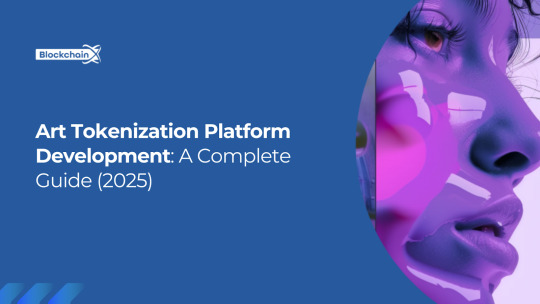
What Is Art Tokenization?
The process of tokenizing art refers to the conversion of ownership rights in an artwork into digital tokens stored on a blockchain. These tokens thus may grant complete or fractional ownership of the artwork, providing for more than a single investor to hold shares in a specific artwork. Another essential detail included in the smart contract behind each token is the provenance of the artwork, ownership history, and resale royalty terms.
This procedure empowers the art industry against counterfeit acts while improving liquidity and authentication. Physical artworks that can be tokenized are rare paintings, digital arts, animations, photographs, and even AI-generated images. From an investment perspective, this is exciting because this model allows a much wider population of investors to participate while allowing artists to reach worldwide markets and maintain control over resale prices for their creations.
Why Build an Art Tokenization Platform in 2025?
There has never been a more apt time to launch an art tokenization platform. Fractional ownership is at an all-time high, especially among millennial and Gen Z investors who are looking at alternative assets. With the passing years, this burgeoning technology has matured to the stature of being readily available and reliable for real-world applications like art investments.
In addition, the traditional art industry is slowly warming up to digital innovation, with galleries, auction houses, and museums looking into tokenized models as an avenue to grow their business. Artists are also in search of further streams where they can monetize their works without depending heavily upon intermediaries. Your platform can cater to that by creating a digital marketplace where artists, collectors, and investors can interact seamlessly and securely.
Features of an Art Tokenization Platform
An art tokenization platform needs to be built from functionality and user experience. Fundamentally, the platform should allow users to register, carry out a kind of identity verification (KYC/AML), and specify their wallets for buying and selling art. Artists can mint NFTs (principally, ERC-721 or ERC-1155) and set fractional ownership settings.
The backend should allow smart contracts to issue tokens and transfer ownership and royalties automatically. Since the users could also want to pay via fiat, integrating payment gateway systems that are secure would be most ideal. Besides, the platform should facilitate a marketplace with search and filtering options, portfolio management dashboards, and secure storage (IPFS) for artwork metadata. An efficient admin panel would also need to keep track of transactions, user activities, and compliance requirements.
Step-by-Step Development Process
In the development of the platform, one must understand its purpose and target audience. Is it to be designed for independent digital artists, for fine art institutions, or for global-level investors? Such a decision will shape the entire feature set and marketing efforts of the platform. Next should be the design of a user interface that is familiar to digital-age users and very attractive to classical ones; navigating through the platform should hardly be a task for anyone. Now comes one of the principal decisions to be made: the choice of blockchain.
Ethereum continues to be an attractive blockchain, perhaps for its strength and its vast ecosystem. On the contrary, chains such as Polygon, Tezos, and Solana seem to be a bargain from the point of view of cheap transaction fees and better scalability. Next, prepare to develop your smart contracts, interpreting how NFTs are minted, sold, and resold and a bit of logic around royalties and access rights. Then frontend and backend development will take care of integrating secure wallets, listing artworks, and creating user dashboards for the platform.
You should test rigorously for both smart contract exploits and performance issues. When the time comes, the launch plan will focus on onboarding artists, building a community, and running global marketing campaigns aimed at the Web3 space.
Revenue Models and Market Opportunities
An art tokenization platform can be monetized in various ways. Good money can be made by charging artists listing fees to mint and display their work; at the same time, the platform might collect small commissions from every sale and resale to ensure that some revenue keeps rolling through it. In the case of fractional ownership, the platform would earn by selling shares of very expensive artworks.
Furthermore, premium services could be marketed for subscriptions or just one-time use fees. Such services include artist verification, featured listings, marquee promotions, and an analytics dashboard. An emerging trend is to license your technology to other entities-galleries or museums-on a white-label basis. As such platforms gain mainstream acceptance, they should scale rapidly and tap into international markets, carving out new avenues in both investment and creative industries.
How BlockchainX Can Help You Build Your Art Tokenization Platform
BlockchainX brings the talent along with years of experience in tokenization and decentralized applications. We provide full-stack solutions for art tokenization platforms-from smart contract design to the deployment and maintenance of the platform. Our team of developers can build a fully custom platform or supply you with a white-labeled solution that can be launched in record time.
If you're looking for an Ethereum developer, Polygon developer, Tezos developer, or Solana developer, or one of any other sorts of developers, we've got the other thing we do is help with compliance integrations, such as {KYC/AML injection}, royalty frameworks, secure storage of metadata, and more. By making it easy to purchase blockchain-powered art, our goal is to enable creators, investors, and innovators. BlockchainX stands with you in developing your project, whether it is building it from scratch or growing an existing concept.
Conclusion
Art tokenization is no passing trend-it's a digital revolution reshaping the systems of ownership, investment, and experiencing art. By developing a custom tokenization platform, you will be embracing the new age and forging a bridge between art and blockchain. With features that highlight transparency, fractional ownership, and global access, your platform can become a worthy instrument for artists and collectors. As 2025 opens doors to opportunities in the Web3 world, there couldn't be a better time to realize your platform. Let BlockchainX spin the future of tokenized art with you.
0 notes
Text
Visa Introduces the Visa Tokenized Asset Platform
Revolutionizing the Future of Finance
In a groundbreaking move, Visa has unveiled its new platform, the Visa Tokenized Asset Platform, designed to transform the way we interact with real-world assets. This innovative platform leverages the power of blockchain technology to tokenize assets, offering unprecedented opportunities for investors, businesses, and individuals alike.

What is Asset Tokenization?
Asset tokenization is the process of converting real-world assets, such as real estate, precious metals, or fine art, into digital tokens on a blockchain network. These tokens represent ownership or fractional ownership of the underlying asset, making them highly liquid and tradeable.
Benefits of Asset Tokenization
The Visa Tokenized Asset Platform offers numerous advantages, including:
Enhanced Liquidity: Tokenized assets can be easily traded on decentralized exchanges, providing greater liquidity and accessibility.
Fractional Ownership: Investors can purchase fractional ownership of assets, making them more affordable and accessible to a wider range of participants.
Increased Efficiency: The blockchain's transparency and automation streamline processes, reducing transaction costs and settlement times.
Improved Security: Blockchain technology offers robust security features, protecting assets from fraud and counterfeiting.
New Investment Opportunities: Tokenization opens up new investment opportunities, allowing investors to diversify their portfolios with a wider range of assets.
The Visa Tokenized Asset Platform
The Visa Tokenized Asset Platform is a comprehensive solution that enables the creation, issuance, and trading of tokenized assets. Key features of the platform include:
Tokenization Services: Visa offers a range of tokenization services, including asset assessment, token creation, and marketplace integration.
Security and Compliance: The platform adheres to strict security and compliance standards, ensuring the protection of investor funds and adherence to regulatory requirements.
Global Reach: Visa's extensive network provides global reach, enabling seamless transactions across borders.
Integration with Existing Systems: The platform can be easily integrated with existing financial systems and infrastructure.

Real World Asset Tokenization Development with Shamla Tech
As a leading provider of blockchain solutions, Shamla Tech is at the forefront of real-world asset tokenization development. With a team of experienced developers and industry experts, Shamla Tech offers comprehensive tokenization services, including:
Custom Token Development: Shamla Tech can create tailored tokenization solutions to meet your specific needs.
Smart Contract Development: Our experts develop secure and efficient smart contracts to govern tokenized assets.
Blockchain Integration: We integrate tokenized assets with existing systems and platforms.
Regulatory Compliance: Shamla Tech ensures that tokenization projects comply with relevant regulations.
Conclusion
The Visa Tokenized Asset Platform represents a significant milestone in the evolution of finance. By leveraging the power of blockchain technology, Visa is unlocking new opportunities for investors, businesses, and individuals alike. With its focus on security, efficiency, and global reach, the platform is poised to revolutionize the way we interact with real-world assets.
#Real world asset tokenization development#RWA tokenization services#asset tokenization#benefits of real world asset tokenization#tokenized asset development company#Shamla Tech#Visa Tokenized Asset Platform.
0 notes
Text
Liquid Staking for Novices: A 2024 Introductory Guide
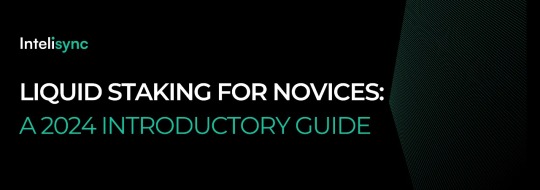
Unlock the full potential of your cryptocurrency investments with liquid staking, where liquidity meets profitability.
Liquid staking is transforming the cryptocurrency landscape by offering a solution to the liquidity problem associated with traditional staking. By issuing Liquid Staking Tokens (LSTs), this innovative approach allows users to stake their assets while retaining the ability to trade or use these tokens in various DeFi protocols. This dual benefit of earning staking rewards and maintaining liquidity makes liquid staking an appealing option for investors, particularly those involved with major cryptocurrencies like Ethereum and Solana.
Liquid staking is transforming the cryptocurrency landscape by offering a solution to the liquidity problem associated with traditional staking. By issuing Liquid Staking Tokens (LSTs), this innovative approach allows users to stake their assets while retaining the ability to trade or use these tokens in various DeFi protocols.
This dual benefit of earning staking rewards and maintaining liquidity makes liquid staking an appealing option for investors, particularly those involved with major cryptocurrencies like Ethereum and Solana.
The process of liquid staking involves depositing cryptocurrency into a staking contract, which then issues a liquid staking token representing the staked assets. These tokens can be utilized in decentralized exchanges, lending platforms, and yield farming protocols, providing users with the flexibility to optimize their investment strategies. This increased liquidity and flexibility allow users to respond quickly to market changes and new investment opportunities, making liquid staking a valuable tool in the crypto ecosystem.
Despite its benefits, liquid staking presents certain challenges, including the risk of validator penalties and smart contract vulnerabilities. Additionally, the regulatory environment for cryptocurrencies is continuously changing, which may impact staking practices. Nonetheless, liquid staking is poised to play a pivotal role in the future of blockchain finance, enhancing the value of crypto assets through improved accessibility and liquidity. Intelisync offers tailored blockchain solutions, including liquid staking, to help businesses Learn more.....
#Advantages of Liquid Staking Tokens#Can I lose my funds in liquid staking?#Challenges of Liquid Staking#How do I choose a liquid staking platform?#How Does Liquid Staking Work?#How Intelisync will help you to grow in the crypto world Liquid Staking#Understanding Staking and How Does Staking Work?#What cryptocurrencies support liquid staking?#What is Liquid Staking?#What is Restaking#What is the future of liquid staking?#Why Are LSTs Gaining Popularity?#intelisync blockchain development company intelisync bitcoin development services#intelisync web3 marketing services
0 notes
Text
Real World Asset Token Development - Beleaf Technology
Beleaf Technology develops digital tokens related to real-world asset tokens, such as real estate or commodities. Simplifying complicated transactions, they enables secure and transparent deals. Through blockchain, they create a seamless connection between conventional assets and digital money. Efficient, trustworthy, and accessible, We lay the path for a future where investing is straightforward and inclusive.
Website: https://www.beleaftechnologies.com/real-world-asset-token-development
Contact details
WhatsApp: +91 7904323274
Skype: live:.cid.62ff8496d3390349
Telegram: https://telegram.me/BeleafSoftTech
Mail to:[email protected]
#Real World Asset Tokenization services#RWA Tokenization platform#Asset Tokenization Services#real world asset tokenization platform development#Real World Asset Digital Asset Tokenization services#Real world asset token development
1 note
·
View note